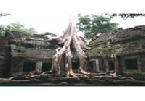|
Ho Chi Minh’s Mausoleum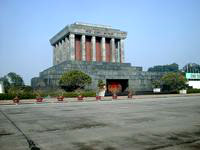
Ba Dinh Square was where, in 1945, Ho Chi Minh read out the Declaration of Independence and where independence is celebrated each year. Dominating the west side is the Ho Chi Minh Mausoleum where the embalmed body of the 'father of the modern state', 'liberator of the Vietnamese people' and beloved public figure is displayed. The body of Ho Chi Min is enclosed in a glass case, the traditional way to honor famous communist leaders. Security is tight, there is a strict dress code and it is imperative to maintain a respectful demeanor while inside. Nearby is the Ho Chi Minh Museum that commemorates his life, housing a collection of military orders, correspondence, manifestos and photographs that illustrates the crucial role he had in the country's history.
Address: Hung Vuong and Le Hong Phong Streets, Ba Dinh Square
Telephone: (04) 3845 5128
Transport: Cyclo from the centre
Opening time: Open from Tuesday to Thursday and weekends from 7.30am and 10.30am (8am to 11am in winter). Closed on Mondays and Fridays. The mausoleum is closed for two months of the year, usually October and November, when Ho Chi Minh’s body goes to Russia for maintenance
Admission: Free, but a donation is expected
One Pillar Pagoda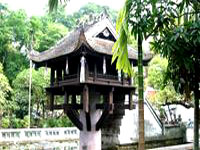
One Pillar Pagoda was constructed to celebrate the tale of the heirless Emperor Ly Thai Tong, who dreamt about receiving a son from the Buddhist goddess of mercy and compassion, seated on a lotus flower. He married shortly after and bore a son, and the pagoda was built to honour the event. It is the most interesting of the city's numerous pagodas, and beneath the ornate curved roof people come to pray for fertility and well-being, with allegedly miraculous effects. The unique wooden structure was designed to resemble a lotus flower, the Buddhist representation of enlightenment, emerging out of the water, with the single stone pillar its symbolic stalk.
Address: Ong Ich Kiem Street, Ba Dinh District
Opening time: Daily from 8am to 5pm
Admission: Free, but a donation is expected
Temple of Literature (Van Mieu)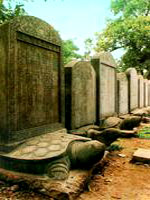
The Temple of Literature is Vietnam's historical seat of learning and is the most sacred place for the disciples of Confucius. It is one of the few remaining buildings from the original city founded by Emperor Ly Thanth Tong in the 11th century and is a well-preserved example of Vietnamese architecture. It became the site of the country's first university in 1076. Consisting of a complex of small buildings and five walled courtyards, it was an exclusive establishment teaching the principles of Confucius. Over a period of 900 years thousands of Vietnamese scholars graduated from the university. In the third courtyard is a pond, the Well of Heavenly Clarity, and beside it are 82 stone stelae, mounted on tortoises and engraved with the names of successful graduates. There is also a temple dedicated to Confucius and an altar where the king and his mandarins would make sacrifices.
Address: Pho Van Mieu, corner of Pho Quoc Tu Giam
Telephone: (04) 3942 1061
Opening time: Open daily from 7.30am to 6pm (summer), and 8am to 5pm (winter)
Admission: 12,000d, and 20,000d for an English-speaking guide
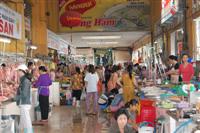
Dong xuan Market
Today the market caters to the tourist dollars and is packed tight with stalls selling clothing, pottery, souvenirs, jewels and food. It is rumoured that depending on bargaining ability buyers will be given their purchase in various coloured bags as a sign to other vendors. The market was moved to its current building in 1912 but has existed in the area for hundreds of years. The permanent stalls are passed down in family for generations. Some of Vietnam's specialties can be bought cheaply here such as cobra and scorpion whiskey and silks. The market is open daily from 8 a.m. to 6 p.m. but an outdoor night market and food stalls surround the area until much later.
Opening time: Daily from 8am to 6pm
Hoan Kiem Lake, Lake of the Returned Sword, Hanoi
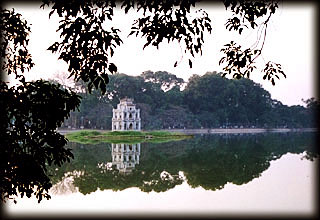 Ho Hoan Kiem or Lake of the Returned Sword was once a part of the Red river (song Hong). Through thousands of years of changes in the geography, the lake moved eastward to its present position many kilometers from the river. The lake was once called Luc Thuy or Green Water because the water was green year round. In the fifteen century, the lake was named Ho Hoan Kiem, based of a legend that is quite similar to King Arthur and the Lady of the Lake's legend. Ho Hoan Kiem or Lake of the Returned Sword was once a part of the Red river (song Hong). Through thousands of years of changes in the geography, the lake moved eastward to its present position many kilometers from the river. The lake was once called Luc Thuy or Green Water because the water was green year round. In the fifteen century, the lake was named Ho Hoan Kiem, based of a legend that is quite similar to King Arthur and the Lady of the Lake's legend.
While fighting against the Chinese, King Le Thai To has in his possession a very valuable sword. After 10 years of continuous struggle, the King finally defeated the Chinese and reclaimed Vietnam's independence. One day, while sailing on lake Luc Thuy, a large turtle appeared. The king drew his sword and pointed at the creature. The turtle immediately grab hold of the sword with its mouth and submerged. The king mourned the lost of such valuable sword, demanded that the lake be emptied and dredged. Both the turtle and the sword were not found. The king realizing that the gods must have lent him the sword to drive back the enemy, but now that Vietnam is free, the sword must be returned. King Le Thai To named the lake Ho Hoan Kiem or Lake of the Returned Sword.
Since the reign of king Le Trung Hung (XVI century), every king in the Le dynasty, and Lord Trinh have all contributed to the beautification of the lake. Lord Trinh Giang built Khanh Thuy shrine on Ngoc island on the north end of the lake. He also had the two man made hills built across from Ngoc son Shrine.
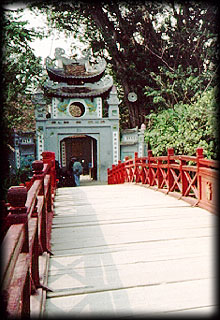
At the end of the Le Dynasty, Khanh Thuy was destroyed by Chieu Thong. A philanthropist named Tin Trai built Ngoc Son pagoda. Ngoc Son pagoda was renamed Ngoc Son shrine during the reign of Thieu Tri III (1843) because it was no longer a Buddhist shrine. Instead, Ngoc Son is a shrine to Van Xuong, a deity, in charge of literature and the various tests required to become a mandarin. It is also a shrine to general Tran Hung Dao, a national hero responsible for many victories against the Mongols.
Since then Ngoc Son has gone through many renovations, one of which was the addition of Thap But (Pen Tower) on the hill which was once called Dao Tai. Three words inscribed on the tower "Ta Thien Thanh "or "write on blue sky". Inside the gate a pool resembling the shape of an ink well was added. Beyond the ink well is The Huc bridge or "where the sun light is absorbed". The bridge leads to Dac Nguyet Lau or "Moon Light tower "- Ngoc Son shrine. Beyond the gates to the shrine, there are two walls called bang Rong and bang Ho (dragon and tiger slate) where the names of those who passed the national test are inscribed.
On the southwest end of the lake is Thap Rua. It was rumored that king Le Thanh Tong used to fish here. Lord Trinh also built the structure to house his entourage while visiting the lake.
Vietnam's small and pleasant capital lies at the heart of the northern Red River Delta, and is a city of lakes, leafy boulevards and open parks with a French colonial feel.
|




 Ho Hoan Kiem or Lake of the Returned Sword was once a part of the
Ho Hoan Kiem or Lake of the Returned Sword was once a part of the 







